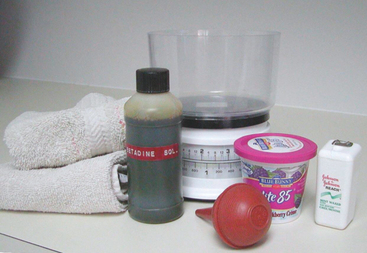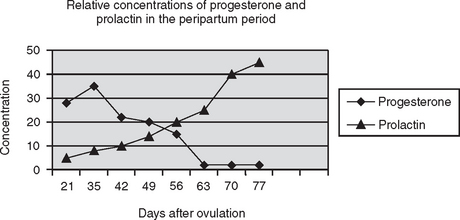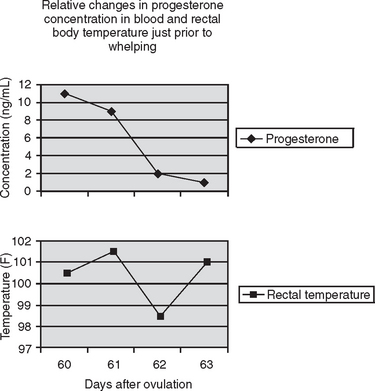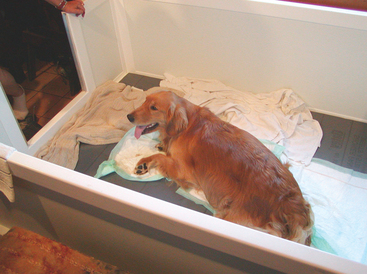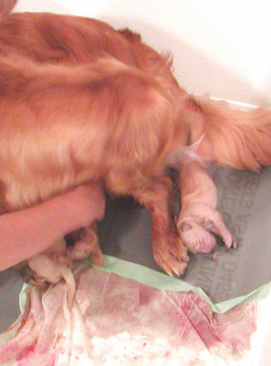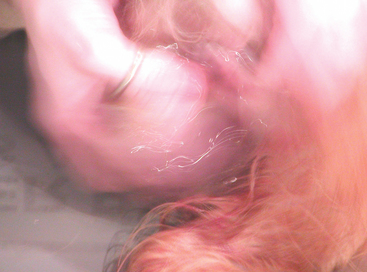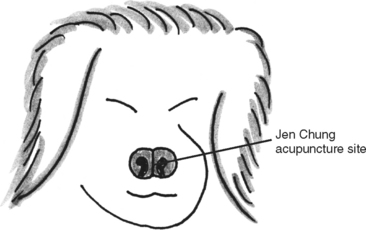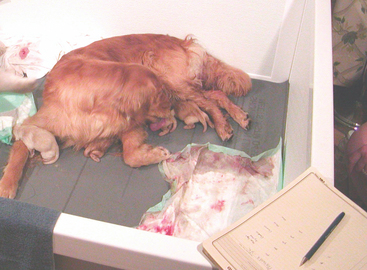12 Parturition and Dystocia
Ovariohysterectomy (spay) at the time of C-section is a good idea for bitches that have finished their breeding career because it saves the bitch from having to undergo anesthesia more than once. Milk production is stimulated by prolactin, which is released from the pituitary gland at the base of the brain. Dogs do not need their ovaries and uterus to make milk.
I. LATE PREGNANCY
Preparation of the bitch and the environment should occur well ahead of the projected whelping date (see Chapter 10). Materials to have on hand prior to whelping include towels, a bulb syringe, sewing thread or dental floss, iodine, a postal scale or small food scale, vanilla ice cream, and your veterinarian’s phone number (Figure 12-1).
Gestation length in dogs most commonly is reported to be 63 days. However, that gestation length is from ovulation, not from breeding. It has been demonstrated that gestation length timed from ovulation in most bitches is from 62 to 64 days. Gestation length timed from breeding can vary from 58 to 71 days. Remember that bitches stand to be bred for a large window of time around ovulation and that spermatozoa may live for more than a week after introduction into the bitch’s reproductive tract. Therefore, if a bitch is bred very early and does not conceive until well after breeding, she will have an apparent prolonged gestation. Conversely, if a bitch is bred late and conceives very soon after breeding, she will have a shortened gestation. Bitches should not be considered overdue until 65 days after ovulation or 72 days from breeding.
It is the fetuses that initiate labor. The exact sequence has not been determined in the dog, but it is hypothesized to mimic the system found in sheep. In sheep the lamb releases adrenocorticotropic hormone (ACTH) from its pituitary gland. That ACTH enters the ewe’s circulation and causes her adrenal gland to release cortisol. Cortisol starts a hormonal cascade terminating in a decline in progesterone, a slight rise in estrogen, and an increase in prostaglandin (Figure 12-2). This allows uterine contractions to increase in frequency and strength.
A decline in progesterone concentrations is reflected by a decline in body temperature. Progesterone, when present at high concentrations in blood, is associated with high body temperature. When progesterone concentrations fall precipitously, as occurs just before parturition, there is a transient de crease in body temperature. If rectal temperature is measured four times daily, beginning about a week before expected date of whelping, a decline in body temperature of greater than 1 degree often is identified. Most bitches begin whelping within 24 hours of this temperature drop (Figure 12-3). This is not a consistent phenomenon; some bitches apparently have such a gradual decline in progesterone concentration that other thermoregulatory mechanisms prevent the decline in body temperature, and other bitches have several drops in progesterone, each accompanied by a decline in body temperature.
Sometimes a question arises as to whether or not a bitch is at term. Ideally, breeding management is done when the dog was in heat, allowing identification of the date of ovulation. Parturition occurs with good regularity 62 to 64 days after ovulation. This coincides with 56 to 58 days from the first day of diestrus (see Chapter 9). Measurement of serum progesterone and radiographs also can be used to determine whether a bitch is at term (Table 12-1). It is important not to try to induce labor or perform a cesarean section too much before term. Pups do not lay down surfactant, the lining of the lung, until the final days of gestation and so will have difficulty breathing and be prone to respiratory tract infection if born prematurely.
Table 12-1 Methods for Determining Term Pregnancy
| Method | Interpretation |
|---|---|
| Timing from ovulation or onset of diestrus | Ovulation date is determined by measurement of the LH peak or of progesterone in blood. Whelping occurs 62 to 64 days later. Onset of diestrus is determined by vaginal cytology. Whelping occurs 56 to 58 days later (see Chapter 9). |
| Rectal temperature | A transient decrease in body temperature by one degree or more occurs concurrent with the drop in progesterone just before parturition. Stage 1 labor usually begins within 24 hr of the temperature drop. |
| Measurement of progesterone in blood | Concentration of progesterone must fall before uterine contractions can occur. A decline in serum progesterone to 2 ng/mL is usually followed by onset of labor within 24 to 48 hr. |
| Radiographs | Puppies mineralize from the center of the body outward. The last tissues to mineralize and become visible on radiographs are the paws, bones of the tail, and teeth. If these structures are visible, the bitch is within 4 days of whelping and any pups born probably would survive. |
LH, Luteinizing hormone.
II. EUTOCIA (NORMAL PARTURITION OR WHELPING)
The onset of stage 1 labor may be difficult to define precisely. The bitch’s cervix is dilating, but she is not having strong, coordinated abdominal contractions. She may be restless and panting (Figure 12-4). She usually refuses to eat and may vomit. This stage may last for up to 12 hours in normal bitches. Intervention is recommended if the bitch does not enter stage 2 labor, with obvious contractions, within 12 hours. Prolonged stage 1 labor (i.e., >18 hours) has been associated with increased incidence of stillbirths and neonatal death.
During stage 1 labor, the hormones relaxin and oxytocin contribute to relaxation and dilation of the cervix. Because of the extreme length of the canine vagina, the cervix is not palpable. If a circumferential constriction is felt when a gloved finger is passed into the vagina, it probably is a ring of vaginal tissue, not the cervix.
Bitches may pass a fair volume of clear fluid from the vulva before a puppy is passed. Green vulvar discharge also may be seen. The green coloration arises from the edge of the placenta and indicates that placental separation has occurred. Pups may be born within a clear sac, or the sac may rupture as the pup moves through the birth canal or be ruptured by the bitch as the puppy passes through the vulva (Figures 12-5 and 12-6). The bitch should vigorously lick the newborn pup to stimulate respiration. She also should shear the umbilical cord with her teeth.
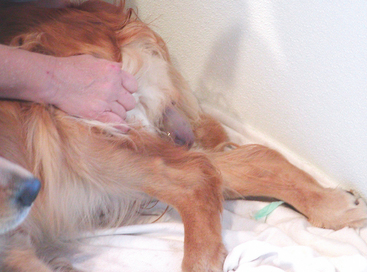
Figure 12-5 Bitch in stage 2 labor. Note the pup at vulvar lips being passed within the amniotic sac.
If the bitch does not tear the sac away from the pup and stimulate respiration, you must do it (Figure 12-7). Tear the sac away with your fingers, use a bulb syringe to suck fluid out of the pup’s nose and mouth, and vigorously rub the pup with a towel. The use of the respiratory stimulant doxapram has fallen from favor in human and veterinary pediatric medicine. I do not recommend “flinging” the pup to move fluid out of its respiratory tract by vigorously swinging it with head down. Blowing air into the nose may help to provide oxygen to the pup. Insertion of a needle into the tissue between the nostrils (the Jen Chung acupuncture site) and twisting the needle as it hits bone may stimulate respiration (Figure 12-8). The umbilical cord can be tied off with sewing thread or dental floss. Tie off the cord about 1 inch away from the pup’s body and again 1 inch from there. Cut between the two ties, and clean the exposed tissue with a disinfectant such as iodine.
It may take up to 4 hours for the first pup to be born, and puppies should be born within 2 hours of each other. Intervention is recommended if the bitch has had intermittent straining for 4 hours with no pups born, hard and constant straining for 30 minutes with no pup born, or if it has been more than 2 hours between pups. Accurate record keeping is essential (Figure 12-9).
< div class='tao-gold-member'>
Stay updated, free articles. Join our Telegram channel

Full access? Get Clinical Tree


